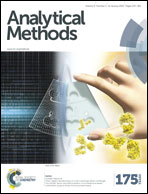Heparin sodium-selective ‘on–off’ and lysine-selective ‘off–on’ fluorescence switching of cadmium telluride quantum dots and their analytical applications†
Abstract
Sensing biomolecules such as heparin sodium and lysine are of great significance. In this work, a “turn-off–on” fluorescence switching of cadmium telluride quantum dots (CdTe QDs) was designed for both heparin sodium and lysine. Even though both heparin sodium and thioglycolic acid (TGA)-capped CdTe QDs are negatively charged, they are capable of forming a self-assembly and even aggregates through hydrogen bonding, depending on the concentration of heparin sodium, which leads to the sensitive fluorescence quenching of CdTe QDs. Thus, a fluorescence ‘turn-on’ analytical method for heparin sodium sensing could be established with a detection range of 0.200–5.000 μg mL−1 and the detection limit was 0.033 μg mL−1, which is applicable to determining heparin sodium in injection samples. What's more, a sensitive and selective “turn-off–on” nanosensor was developed for lysine analysis with the detection range of 2–200 μmol L−1 and the detection limit as low as 0.146 μmol L−1. This approach offers a new, simple, fast and selective method for determining heparin sodium and lysine.


 Please wait while we load your content...
Please wait while we load your content...